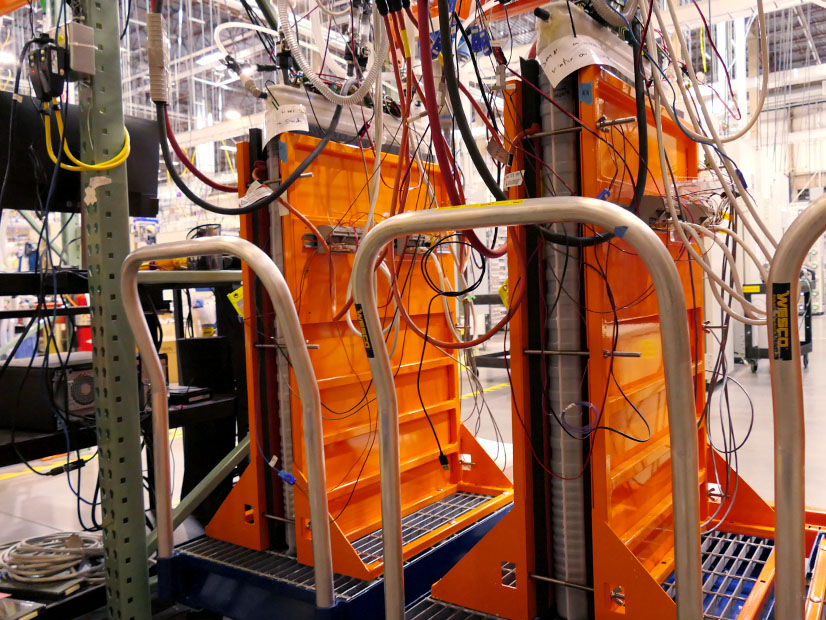A major multiday energy storage project in central Maine intended to ease congestion is moving forward thanks to $147 million in federal funding.
The 85-MW battery project will be located in the town of Lincoln, Maine, and has a projected in-service date of 2028, contingent on the timeline on interconnection, permitting and community engagement.
Form Energy, the project developer, has attracted significant attention for its iron-air battery technology that it says can discharge for up to 100 hours. The early-stage company has yet to bring any large-scale projects online but expects several to be operational in 2025. The Maine battery project is its largest proposal announced to date. (See Form Energy Wants to Bring Long-duration Storage to New England.)
The federal funding stems from a $389.3 million Department of Energy grant to the New England states for the Power Up New England project, which also includes a major investment in substations in southern New England to interconnect offshore wind projects. (See DOE Announces $2.2B in Grid Resilience, Innovation Awards.)
The storage project is “intended to address grid resilience and reliability throughout ISO New England,” Form CEO Mateo Jaramillo told RTO Insider. He noted that the states were particularly drawn to the battery’s ability to reduce congestion and balance the output of wind power in northern Maine.
Jaramillo noted that wind patterns often vary over multiple days, creating a need for resources that can store excess energy and balance out intermittencies over extended periods.
“Having the type of storage resource that is well matched to that period of intermittency that comes from wind is why this battery in particular [is] well suited to address the congestion challenges that come from wind,” he said.
Congestion costs in New England are relatively low because of transmission investments made over the past two decades; ISO-NE’s External Market Monitor noted in its 2023 report that “congestion levels per MWh of load in the other RTOs were six to 11 times higher than in New England based.”
However, the RTO’s Internal Market Monitor has indicated that northern Maine is the part of the region where generation is most limited by transmission constraints, affecting the development of new renewable resources in the area. As electricity demand increases and renewables proliferate, transmission constraints likely will become a greater issue. ISO-NE estimates that transmission upgrades needed by 2050 could cost up to $26 billion. (See ISO-NE Prices Transmission Upgrades Needed by 2050: up to $26B.)
While this project is centered around onshore wind, offshore wind is likely to face significant transmission constraints as it scales up. ISO-NE’s 2050 Transmission Study found a high likelihood of overloads on north-south transmission lines during periods of high offshore wind generation, although the extent of overloads is dependent on where offshore wind projects interconnect. (See ISO-NE Analysis Shows Benefits of Shifting OSW Interconnection Points.)
Form has not announced other projects in New England, but Jaramillo said the company is working to bring other projects online in the region.
“I don’t at all expect this to be the only project in New England in the next few years,” Jaramillo said. “This is certainly on the larger side of what we expect, but there’s other clear opportunities that we’re pursuing on the same time horizon.”
While the project is supported by a mix of federal and private funding, Jaramillo said it is “still to be determined how much of the funds to cover the investment will come from the market.”
ISO-NE is in the middle of an extended effort to update how it values different resource types in its capacity market, aiming to better align capacity awards with reliability benefits. The RTO plans to implement the reforms for the 2028/29 capacity commitment period. (See ISO-NE Outlines ‘Straw Scope’ of Capacity Market Reforms.)
The new accreditation process likely will increase the financial incentives for longer-duration energy storage resources. Existing capacity market rules provide little incentive for storage resources to increase their duration beyond two hours. (See ISO-NE Capacity Accreditation Reforms Spur Energy Storage Concerns.)
“Form will be the owner of the asset, and so we’re very interested in making sure that the right market products are there in the ISO to compensate for the value that we bring,” Jaramillo said.
As the region’s winter risk increases, long-duration batteries would help boost winter grid reliability by balancing wind resources, which often perform better with lower temperatures, Jaramillo said.
“What we’re bringing is a new type of asset,” Jaramillo said. “An integrated system that has this type of asset in the end is a more reliable system.”



